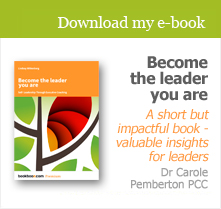blog
What is reflection?
Given the role of reflection in coaching (and leadership) as the secret sauce that makes a key difference to the value of the coaching, what is it, actually?
First of all, reflection after a coaching session, or after a learning experience between sessions, is space for enquiry, to build on the content of the coaching session or the experience, to surface more of what you’re curious about and what you’ve learnt. It’s a chance to step back from the coalface of daily working life and from the detail of the question, the challenge or the issue that you might be bringing as a leader to your coaching. It’s space to consider additional perspectives that you might not have thought of to begin with. Stimulated by the coaching session or the experience, it’s space to be with the challenges, to allow the time for new thoughts and ideas to emerge at their own pace, and with the richness that can come when pressure is absent.
And secondly, it’s time to be with yourself, just you and you, with the ease to allow thoughts and intuitions to surface – thoughts and intuitions that can hide when we’re caught up in the busyness and noise of doing, but which can be signposts to what doing, and what kind of doing, actually matter. They can help us make sure that we’re focusing on the appropriate things, at the appropriate time, with appropriate people.
What’s in reflection?
While it includes the recall of events, in effective reflection that recall is supplemented by curious exploration and enquiry into why things happened the way they did: what were the messy bits, the puzzling bits, the successful bits? What behaviours, and on whose part? What values? What assumptions and beliefs? Who do the participants in the situation take themselves to be: what’s their sense of identity?
What influence did you as leader have – knowingly or unknowingly – on the situation? What choices did you have – again, knowingly or unknowingly? What might have been alternative ways of approaching the situation? How reflective were you in the moment?
Perspectives of complexity
The scope of reflection to open up the perspectives of complexity – the interdependencies, the variety of stances you could take, the embracing of different views, the attachments you might have to ideas or beliefs, the ways you used your power (and where that power resided), the experiments you put in place as you found your way through complexity, step by step – is invaluable. As is the constant enquiry into what you’re curious about at any given moment.
Reflection allows us to become aware of our selves at a new level, of our options, our possibilities and our responsibilities. It applies to the fulfilment of leadership as much as it does to coaching.
And very importantly, it’s a space where we can distil what we’ve actually learnt, what change we want to create from that learning, and what we become aware of that’s changed or changing.
A complement to coaching sessions
It’s a necessary complement to coaching sessions, which can only ever be part of the learning and development story, and not the whole story. Reflection is part of the engagement that the leader needs to bring if they’re to get much, let alone much that’s sustainable, out of their coaching. I have worked with clients who wanted to squeeze in their coaching in a short space between one meeting and another, and then forget about it till the next session. With clients who looked to me to find their solutions for them without investing any of their own thought or commitment. With clients who wanted solutions and outcomes before they’d engaged at all in any enquiry into what was actually going on. None of them engaged in meaningful reflection, and none created any meaningful change from their coaching.
An indulgence or a necessity?
Clients have said to me that both the coaching and the reflection felt self-indulgent, which has intrigued me. Can it be that they feel guilty about the time they took to enquire into what’s happening for them and their teams, and thus how development, transformation and improvements can be shaped? If the answer is ‘yes’, that prompts me to reflect on what messages our organisational cultures are giving about expected behaviours – but that’s for another blog.
See The Art of Reflection part 1 for more on reflection and engagement.
Photo by https://unsplash.com/@taelynnmaephoto on Unsplash
The Art of Reflection - part 2
What is reflection? First of all, reflection after a coaching session, or after a learning experience between sessions, is space for enquiry, to build on the content of the coaching session or the experience, to surface more of what you're curious about and what you've learnt. And secondly, it’s time to be with yourself, just you and you, with the ease to allow thoughts and intuitions to surface – thoughts and intuitions that can hide when we’re caught up in the busyness and noise of doing, but which can be signposts to what doing, and what kind of doing, actually matter. Recall is supplemented by curious exploration and enquiry into why things happened the way they did: what were the messy bits, the puzzling bits, the successful bits? What behaviours, and on whose part? Very importantly, it’s a space where we can distil what we’ve actually learnt, what change we want to create from that learning, and what we become aware of that’s changed or changing. It’s a necessary complement to coaching sessions, which can only ever be part of the story, and not the whole story.
Read more »The Art of Reflection - part 1
The key benefits of executive coaching are learning, development and change. Not only a coach enables those benefits, but a leader does too if they’re to get the most from their people and to enable, and boost, the delivery of results. Single Loop Learning is about enlarging the size of the toolbox. Executive coaching can produce results in this context, but they are likely to be limited in scope and over time. Double Loop Learning involves identifying and understanding causality, and then taking action to fix the problem. It’s about doing the right things. Reflection on why we're doing what we're doing is a critical first step, not only for executive coaching to be most effective, but also for leaders to be most effective. Triple Loop Learning explores the reasons why we even have our systems and processes, and why we set our desired results in the way we do in the first place. This is the space in which we can enquire into how complexity works in our environments. It’s a critical contributor to both impactful executive coaching and effective leadership, and can be transformational. And it only happens in the presence of reflection.
Read more »Thoughts on entanglement
It’s so easy to get tangled up as we race through our lives, as a crisis, or even simply the demands of the moment, grasp our attention. In the process the plot – our purpose and our place - of our lives might get completely lost, and we lose sight of the bigger picture. Responsibility matters. Leaders have a responsibility to themselves, to their people, to the healthy co-design and fulfilment of the missions of their organisations, and ultimately to the wider world. In the view of Rabbi Jonathan Sacks (2013), where what we want to do meets what is crying out to be done, that is where we should be. And that demands being in healthy relationship with ourselves, with others, and with the systems we are part of. I’m exploring what becomes possible when I’m not tangled up in the backdrop, by stepping back from what seem to be the immediate imperatives.
Read more »Coaching through COVID and Beyond drawing to a close
Coaching through COVID was born out of a compassionate response to what NHS and care workers were going through when COVID hit the UK in March 2020, and intended most of all to serve, rather than help or fix. It was set up spontaneously by a small group of executive coaches (including myself), and began to offer coaching within days of being launched. After 2½ years, what started as Coaching through COVID, and became Coaching through COVID and Beyond, has drawn to a close, having offered coaching to 650 people, through 250 experienced and qualified coaches, culminating in a final, celebratory (virtual) conference at which we marked the ending.
Read more »Power, voice and the relational nature of work
He was a C-suite leader in a multinational company, fulfilling a demanding, multi-faceted role. His CEO wanted staff in the office four days a week, and he was beginning to feel peripheral to his family. He knew that for his own and his family’s wellbeing he wanted to be in the office only three days a week. He was, however, very hesitant to raise his dilemma with his CEO: he felt out on a limb, risking his sense of belonging. It struck me that the predominant dynamic was an imbalance of power, in contrast to the possibility of creative collaboration, and he didn’t seem to be hopeful that he would be heard. How might leaders enable their people to step into, and leverage, more of their own power? How might both leader and led transform their perceptions of their roles and their places into something less atomised and individualised and something more relational?
Read more »A journey through risk
An emergency admission to hospital..... Until the surgery had been completed and pronounced successful, and the biopsy showed there was no ongoing problem, the nature of what my life was to be was at the extreme end of uncertainty, with a possible threat to it. Being present to my own experience without resisting it, and accepting both the experience and the situation on a moment-by-moment basis, have, I realise, been central. I feel sure that my years of mindfulness practice accounted for my capacity to accept, and to face in to all the available facts and the possible outcomes. During my hospital stay and afterwards I’ve been struck by how many people remarked on my effect on them. For leaders every action, every tone of voice, every conversation has an impact. The leader who accepts mindfully that things are as they are will be realistic and very likely have more insight than the leader who resists a situation they wish was otherwise. They’ll feel calmer too, and that will be viral. The leader who’s appreciative, supportive and caring (and who encourages that sort of culture) will have a workforce with high levels of engagement, discretionary effort, effectivenes and customer satisfaction.
Read more »Slowing down to speed up
A potential client, ‘a man in a hurry’, was looking for answers. Now. Another prospective client slowed down long enough to engage with the notion of the challenge – and the benefits – to him of that very slowing down, because he was interested in ‘exploring the hidden in order to grow’. The nature of organisational life frequently means that leaders are pressured to achieve clear, ‘correct’ outcomes – fast and with urgency. While this is standard, it militates against the possibility of achieving richer, wider, more sustainable outcomes because space hasn’t been made for reflection and for experimenting. A leader might consider becoming aware of when speed is the lived priority, and reflecting on the impact and outcomes of that priority. They might also consider putting in place processes, approaches and forums in which people can honestly express what’s going on for them, be truly heard without being offered opinions or judgments, and be acknowledged for who they are rather than what they do.
Read more »The horse, leadership and me
I’m with a group of colleagues, learning about experiential leadership with executive coach and developer of leaders and teams, Jude Jennison, and her herd of horses. With a horse it’s critical to be in relationship (and useful to be able to identify how that manifests in your body), to be curious, to be present, to respect the horse’s freedom to choose and to offer clear direction. What won’t work is to be concerned about your competence or performance, because the horse will instantly pick up on your insecurity and will feel unsafe. And it’s hard to be in relationship when lack of safety is there. Jude’s insight about the importance of allowing the horse space and freedom so that together we can fulfil the task feels like an important illumination. We learn that the whole team needs to be in sync. Communication up and down the line is essential if the team is to stay cohesive. And the horse needs confidence in the clarity, intention, direction, energy and trust of both the leader and the whole team.
Read more »What’s love got to do with it?
Client A is close to burnout. He constantly over-stretches himself to meet other people’s requests for help and for task fulfilment. As a child, he felt neither loved nor lovable: the only way he ever felt approved of or accepted was through his intellectual ability and achievements. Client B alienates others with her ‘honest’ but brutal and judgmental behaviour, has very high and unforgiving expectations of herself and of others, and is never satisfied with her own performance. These behaviours are getting seriously in the way of their leadership, and they both want to understand how to manage themselves differently. Besides the negative impact on their wellbeing, each is also damaging their career prospects. The coaching enquiry means they each experience a freedom in an awareness that gives them choices that they hadn’t offered themselves before. They learn, each in their own way, that there is strength and safety and a new-found sense of wellbeing in learning self-love, learning how to listen to their own needs, and self-acceptance. Love has everything to do with it.
Read more »Endings and leavings
The primary emotions that arise from losing a sense of belonging need to be attended to, just as much as organisations need to acknowledge the contributions made by those who have left. Endings (and the associated feelings) that aren’t resolved or aren’t fully integrated into a system somehow ‘hang about’ and leave their impact to be felt, sometimes for decades, in the form of burdened roles. A particularly impactful ending is represented by death. There’s value in accepting ‘what is’, and being alert to what may be emerging: experiencing it as a state of being rather than thinking or doing. Loss or ending might actually be, above all, a fertile space – the Gestalt notion of the Fertile Void. Good endings allow for good beginnings.
Read more »











